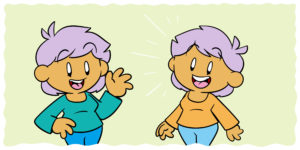I’ve got some bad news and good news for you.
There’s just no substitute for a skilled professional editor; if you’re serious about making your manuscript stand out in the current publishing market, you need an editor. But the good news is, there is a lot of revision and self-editing you can do that can save time and money.
I’ve got 10 ways you can polish your manuscript and set yourself up for success. Take some time to ask yourself the following questions, really examine how your story stacks up to these expectations, and make necessary changes. Your story will be so much stronger for the work you’ve put in.
1. Conflict
Conflict is the heartbeat of your novel; it’s what drives and enlivens every other element of your story. Check to see if you’re making the most of this crucial part of your work in progress.
How does my first chapter mention or allude to the main conflict of my story? This is critical to getting readers to care about what happens to your protagonist from the beginning.
In what ways does this main conflict drive my protagonist through the story to the climax and resolution?
How do other conflicts serve and support the main conflict? You want to make sure that conflict isn’t just thrown into the story for entertainment without pertaining to the story.
2. Plot
Plot is the organized structure of the action that happens in your book. It should be intentional and strategic. Examine your overall plot and each plot point carefully and be sure it measures up.
What is the main plot arc, and does it have a satisfying resolution at the end of the story?
Are there subplots that weave in naturally with and support the main plot?
What makes this an interesting plot that can support the whole book? A big factor here is whether your story explores universal themes that readers can relate to—is this a complex story with lasting ramifications or is it just an entertaining series of events?
3. Pacing
A consistent and textured sense of pacing in your story is essential for keeping readers engaged. Too slow and you’ll lose them, too fast and you risk pulling them out of the story.
How does the rhythm of the story feel? Look for ways that excess narration or unnecessary scenes might be slowing down the story.
How does my prose affect the pace? Writing that’s too wordy, descriptive, or repetitive can slow the pace. For action scenes, use clipped sentences and short paragraphs to reinforce a faster pace.
How do the order and flow of scenes affect the pacing?
4. Tension
Much like pacing, a good sense of tension keeps your readers turning the pages. It’s that undercurrent of tension running through each scene that makes for an engaging read. Some writing gurus even suggest you should be able to identify some element of tension on every page of your book. That’s quite a task.
In what ways is the sense of tension clear from the beginning? One way to check for this is to find your initial conflict, how does tension support and inform that scene?
How do the characters create tension?
Am I making the most of my scene and chapter breaks to heighten tension?
5. Setting
Your story’s setting has the power to transport a reader to another world, another time and place, but it’s more than that. Setting is strategic too; it can reinforce a theme, heighten character qualities, or influence the mood of a scene. When used to its full effect, setting can function almost like another character in the story.
How have I made the setting authentic, consistent, and compelling?
In what ways does the setting serve the plot in each scene? Think mood, theme, conflict, etc.
Do the number and type of locations serve the needs of the story?
Did I adequately and skillfully describe the setting in each scene?
6. Point of View (POV)
Point of view is the type of narration used in your story. Whatever style you use, it needs to be strategic and consistent. As you read through your novel, keep a close eye on the following questions.
Is my POV consistent?
Is there any head hopping? Be sure there’s only one character’s POV in each scene.
Am I actually inside my characters’ heads or am I still telling instead of showing? We need to see the scene through their perspective, using their senses to describe the action and surroundings.
7. Voice
Every author’s voice is unique. If a writer copies someone else’s style, it’s derivative and often rings inauthentic. Writing in your own natural, fresh voice can make your novel stand out and will draw readers into your passion for your story.
Does my sense of voice seem original and authentic?
In what ways do my tone and style fit the needs of my story?
Am I relying on clichés and stereotypes instead of finding original ways to describe and narrate?
8. Characters
Character work is some of the hardest work, but it’s immensely rewarding and makes all the difference to writing a compelling and memorable story. Have you helped your characters to become all they can be?
What makes your protagonist someone your readers can relate to and sympathize with?
Are all characters fully developed or do they fall flat?
In what ways are the characters’ speech, goals, and actions consistent with their backstory?
Is character description used to its full advantage?
How do the secondary characters serve the protagonist’s journey?
Do all central characters have a discernible arc?
9. Dialogue
Getting your dialogue right goes a long way to keeping readers engaged, to propelling the story forward, and to putting readers inside the minds of the characters. But it’s tricky, isn’t it? It’s hard to get authentic and useful dialogue, but it’s well worth the effort.
How are character voices varied, discernible from one another?
Are characters’ speech patterns and word use consistent with their personal history?
Is the dialogue useful and strategic or are there passages of unnecessary filler?
Do I use dialogue well to avoid info dumps?
10. Overview
Now step back and look at your story as one whole piece. This is so hard to do, and I suggest taking some time and distance away from your manuscript to allow yourself to be as objective as possible. These are questions to ask yourself at your very last pass through the manuscript, after you’ve done all other revisions and before you’re ready to send it for copyediting or proofreading.
Does the story work as a whole? Does it make sense and will it be compelling to readers?
What are the themes? Are they clear, universal, and meaningful?
Does the story feel fleshed out, like it has enough scope?
Does the resolution feel satisfying and complete, an appropriate ending from where the story began?
Is this story right for my target audience?
Revision is some of the hardest work we writers do on our novels because it requires us to think on so many different levels. It’s tempting to just write your story, get it done, and send it on to beta readers and editors. But doing this hard work of picking apart your story, looking at its basic elements from all sides, and making necessary changes will transform your story from good to great. I promise you, it’s a labor of love.
How has revising your story helped you to make it stronger? What were some of the hardest decisions you’ve had to make about self-editing your story?






12 thoughts on “10 Self-editing Tips Too Vital To Ignore”
Great tips! I have a tendancy to over edit so it’s good to see what an editor thinks I should do as opposed to what I think I should do.
Hi, Lana. I’m glad you found this article helpful. Keep up the good work!
Timely article for me as I’ve just finished my first draft of my second book.
Currently in the act of revising, and looking at the story as a whole, I now see I have some big changes to make, but knowing it will make it stronger in the end is what keeps me going.
During the process of self-editing, the hardest part is having to remove scenes that I love because they either aren’t necessary or don’t move the story along.
Hi, Suzanne. Congratulations on finishing that first draft! You’re right, that list of changes during revision can be painful and overwhelming. It is so satisfying, though, once you’re on the other side of those edits to see all the good you’ve accomplished. Best of luck with your novel!
Great tips! I’m at the beginning of the self-editing stage with my story right now and am really grateful for any helpful advice like this.
Hi Tom,
I’m glad you found this article helpful at this stage of your writing. Best of luck to you with your editing!
Very useful list! I’ll copy it and read every time 🙂
Food for thought—useful list. Thanks for posting.
Plot is not essential, else please define plot.
I question plot because many acclaimed novels/stories have no plot, just flow. For example, some of Hemingway’s short stories are a delightful flow of descriptions.
On the other hand, I found this: “Plot is a literary term used to describe the events that make up a story or the main part of a story. These events relate to each other in a pattern or a sequence. The structure of a novel depends on the organization of events in the plot of the story.” I find this definition a bit vague.
I also found, “A plot is a causal sequence of events, the ‘why’ of what happens in a story. For example, “The King died and the Queen died,” has no plot, but “The King died and the Queen died of grief,” has a plot, and the plot is essential in this example.
Hi Jim,
Thanks for your excellent question about plot. It’s true that not all novels/stories prioritize plot. But I’d argue that in our current market, the vast majority do. Our contemporary mode of storytelling relies on plot and character arcs developed over the course of the story to convey a message or messages to readers. There is certainly merit to writing that contains “delightful flow of descriptions” as you describe, but this approach is not the norm in the current market. I found this article from The Guardian on the subject (https://www.theguardian.com/books/2011/jul/14/plot-driven-out-other-kinds-story) to be insightful and sympathetic to your perspective that there is more to writing than plot. Let me know what you think of it.
Paige
Thanks, Paige. I’m glad your link refers to James Joyce and Kafka, two plot-less authors.
It seems to be art vs. the marketplace—plots sell, but “Ars gratia artis” (Art is the reward of art).
Paige ~ In reviewing these postings, I am printing this one as guidelines. Thanks again.